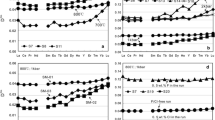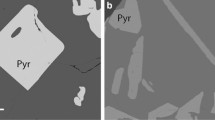Abstract
The parameters which control the behaviour of isovalent trace elements in magmatic and aqueous systems have been investigated by studying the distribution of yttrium, rare-earth elements (REEs), zirconium, and hafnium. If a geochemical system is characterized by CHArge-and-RAdius-Controlled (CHARAC) trace element behaviour, elements of similar charge and radius, such as the Y-Ho and Zr-Hf twin pairs, should display extremely coherent behaviour, and retain their respective chondritic ratio. Moreover, normalized patterns of REE(III) should be smooth functions of ionic radius and atomic number. Basic to intermediate igneous rocks show Y/Ho and Zr/Hf ratios which are close to the chondritic ratios, indicating CHARAC behaviour of these elements in pure silicate melts. In contrast, aqueous solutions and their precipitates show non-chondritic Y/Ho and Zr/Hf ratios. An important process that causes trace element fractionation in aqueous media is chemical complexation. The complexation behaviour of a trace element, however, does not exclusively depend on its ionic charge and radius, but is additionally controlled by its electron configuration and by the type of complexing ligand, since the latter two determine the character of the chemical bonding (covalent vs electrostatic) in the various complexes. Hence, in contrast to pure melt systems, aqueous systems are characterized by non-CHARAC trace element behaviour, and electron structure must be considered as an important additional parameter. Unlike other magmatic rocks, highly evolved magmas rich in components such as H2O, Li, B, F, P, and/or Cl often show non-chondritic Y/Ho and Zr/Hf ratios, and “irregular” REE patterns which are sub-divided into four concave-upward segments referred to as “tetrads”. The combination of non-chondritic Y/Ho and Zr/Hf ratios and lanthanide tetrad effect, which cannot be adequately modelled with current mineral/melt partition coefficients which are smooth functions of ionic radius, reveals that non-CHARAC trace element behaviour prevails in highly evolved magmatic systems. The behaviour of high field strength elements in this environment is distinctly different from that in basic to intermediate magmas (i.e. pure silicate melts), but closely resembles trace element behaviour in aqueous media. “Anomalous” behaviour of Y and REEs, and of Zr and Hf, which are hosted by different minerals, and the fact that these minerals show “anomalous” trace element distributions only if they crystallized from highly evolved magmas, indicate that non-CHARAC behaviour is a reflection of specific physicochemical properties of the magma. This supports models which suggest that high-silica magmatic systems which are rich in H2O, Li, B, F, P, and/or Cl, are transitional between pure silicate melts and hydrothermal fluids. In such a transitional system non-CHARAC behaviour of high field strength elements may be due to chemical complexation with a wide variety of ligands such as non-bridging oxygen, F, B, P, etc., leading to absolute and relative mineral/melt or mineral/aqueous-fluid partition coefficients that are extremely sensitive to the composition and structure of this magma. Hence, any petrogenetic modelling of such magmatic rocks, which utilizes partition coefficients that have not been determined for the specific igneous suite under investigation, may be questionable. But Y/Ho and Zr/Hf ratios provide information on whether or not the evolution of felsic igneous rocks can be quantitatively modelled: samples showing non-chondritic Y/Ho and Zr/Hf ratios or even the lanthanide tetrad effect should not be considered for modelling. However, the most important result of this study is that Y/Ho and Zr/Hf ratios may be used to verify whether Y, REEs, Zr, and Hf in rocks or minerals have been deposited from or modified by silicate melts or aqueous fluids.
Similar content being viewed by others
Author information
Authors and Affiliations
Additional information
Received: 4 September 1995 / Accepted: 30 October 1995
Rights and permissions
About this article
Cite this article
Bau, M. Controls on the fractionation of isovalent trace elements in magmatic and aqueous systems: evidence from Y/Ho, Zr/Hf, and lanthanide tetrad effect. Contrib Mineral Petrol 123, 323–333 (1996). https://doi.org/10.1007/s004100050159
Issue Date:
DOI: https://doi.org/10.1007/s004100050159




